- The moon has craters the earth does not.
- Present theories explaining the lack of craters do not seem credible
- One possibility is that we are missing the circular features (such as the area around Glastonbury)
- Another is that the meteorites don’t leave craters, but pass through the crust like a bullet through glass.
Anyone who has looked at the moon will notice many features:
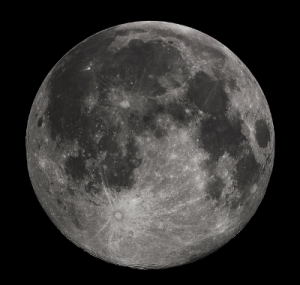 …that are either not present or are hidden on the earth:
…that are either not present or are hidden on the earth:
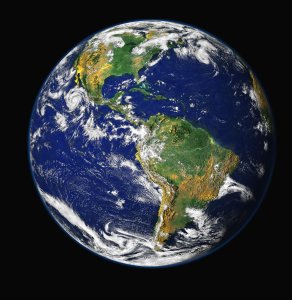 |
 |
And that is the many craters on the moon. Why then is the earth’s surface apparently devoid of these craters. The traditional explanation for this goes along the lines of: “it’s because the surface of the earth gets wiped clean by tectonic plate movements and glaciation and erosion”. But this is hard to reconcile with statements such as this:
Confirmed: Oldest Fragment of Early Earth is 4.4 Billion Years Old (source)
At least some rocks are almost as old as the earth itself, so surely, if the moon is covered in craters then these oldest rocks should have been exposed to meteorites. So their formations should have been affected by meteorite impacts?
And surely, even if the obvious parts of the features themselves were regularly wiped from the “blackboard”, the craters left would still be present in the rocks beneath their surface? And if those circular features still exist in the geology – there ought to be many many such features to find, yet geologists seem to know of very few such craters.
This suggest these potential hypothesis:
- That the craters on the moon represent an era of activity that occurred before the surface of the earth was formed.
- That such craters do exist, but for some reason, geologists have not recognised them as such – perhaps because the geological processes distort them so they are unrecognisable or because they look like something else?
- That meteors impact the earth in a way that does not leave craters as found on the moon.
The first is a great cop out, because I cannot see anyway to prove or disprove that there was an “era of meteorite hits” which has past. It’s possible. But beyond that nothing much can be said (without travelling to other planets and dating craters).
Craters not being recognised as such.
This is one my favourite explanations, because it gives me an excuse to look at maps and try to identify circular(ish) looking features imagining they may be craters. For example here is a map of the Somerset Levels in England (where Glastonbury is) and we can see that it is roughly oval in shape:
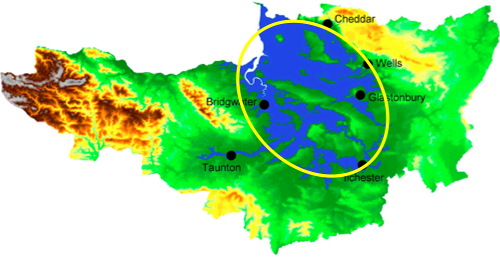 And this is my favourite site, because there’s some evidence it may be true. One linguistic interpretation of “Glastonbury” is that it means the hill of glass. Not far away is the Roman town of bath with it’s hot geothermal springs – and with not too much imagination, you can suggest that the Somerset Levels are an ancient meteorite crater, formed with a glancing blow (hence the oval shape), that Glastonbury tor was formed by a superheating process that turned the sand into glass and that the residual energy is still making its way underground to places like Bath.
And this is my favourite site, because there’s some evidence it may be true. One linguistic interpretation of “Glastonbury” is that it means the hill of glass. Not far away is the Roman town of bath with it’s hot geothermal springs – and with not too much imagination, you can suggest that the Somerset Levels are an ancient meteorite crater, formed with a glancing blow (hence the oval shape), that Glastonbury tor was formed by a superheating process that turned the sand into glass and that the residual energy is still making its way underground to places like Bath.
But when you start looking you can find many such features, such as this one at Ot Moor just NE of Oxford:
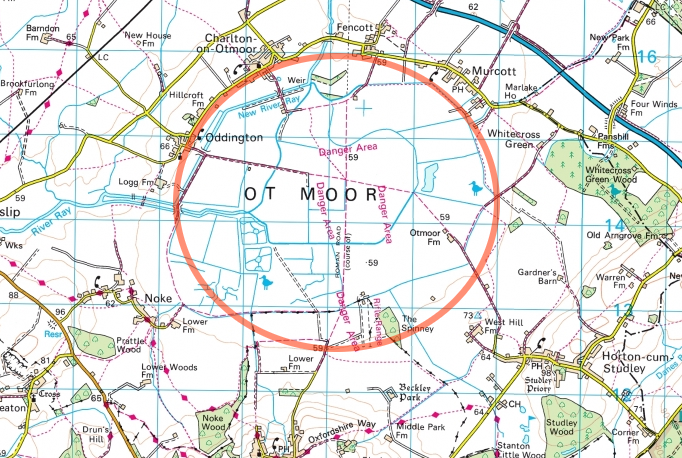
Here we have a circularish feature which has then been infilled to form a flat round depression.
The problem with this approach of looking for such circular features, is that there are many reasons why circular geological features might form for other reasons other than meteorites. For example, just as an irregular rock tends to become rounded into a pebble, so an odd shape which infills from the edge tends to get more circular:
Like the swarms of meteorites in the past, unless we undertook detailed geological surveys of many such circular depression, we will never know. So, let’s examine the last potential explanation. That the meteorites hit in a way that doesn’t leave a crater.
The Gunshot theory of Meteorites
A few days ago,  some vile creature from the alarmist religion tried to aim some shots at Roy Spencer and/or John Christy in an act of eco-terrorism.
some vile creature from the alarmist religion tried to aim some shots at Roy Spencer and/or John Christy in an act of eco-terrorism.
“A total of seven shots were fired into our National Space Science and Technology Center (NSSTC) building here at UAH over the weekend.
All bullets hit the 4th floor, which is where John Christy’s office is (my office is in another part of the building).”
I presume the image right is of one of the holes left in the glass. Let’s take a closer look at the features of that bullet hole:
 |
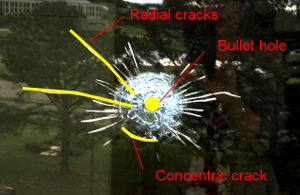 |
We see three distinct features:
- A central bullet hole where the glass has been completely removed by the bullet
- Concentric cracks formed as rings around the central hole (In this case, only one is distinct, but these concentric cracks are largely what makes up the white “blob” is around the bullet hole )
- Radial cracks extending outward from the bullet hole.
But why didn’t the bullet leave a crater like a meteorite? Bullets certainly do leave craters in some surfaces:
The difference is that the window is a layer of hard material whereas if the bullet hits a solid object (or a layer it cannot break through), then it leaves a crater.
But isn’t the main difference between the moon and the earth, that the earth has a molten interior, and so very much like the window, there is a thin solid layer on the surface?
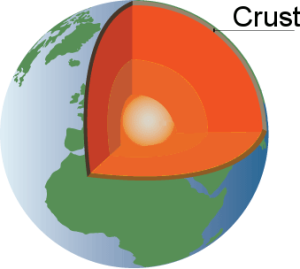 Is it possible that at least some meteorites, instead of forming craters on the surface, passed straight through the crust forming a feature more like a gunshot hole? Obviously, on the earth the hole would have been very quickly filled in by magma boiling up from underneath the crust. So, we wouldn’t expect a hole so much as a centre filled with solidified magma aka Granite. But we would expect to see the radial cracks and perhaps also the concentric ones.
Is it possible that at least some meteorites, instead of forming craters on the surface, passed straight through the crust forming a feature more like a gunshot hole? Obviously, on the earth the hole would have been very quickly filled in by magma boiling up from underneath the crust. So, we wouldn’t expect a hole so much as a centre filled with solidified magma aka Granite. But we would expect to see the radial cracks and perhaps also the concentric ones.Have a look at the geological map of Skye:
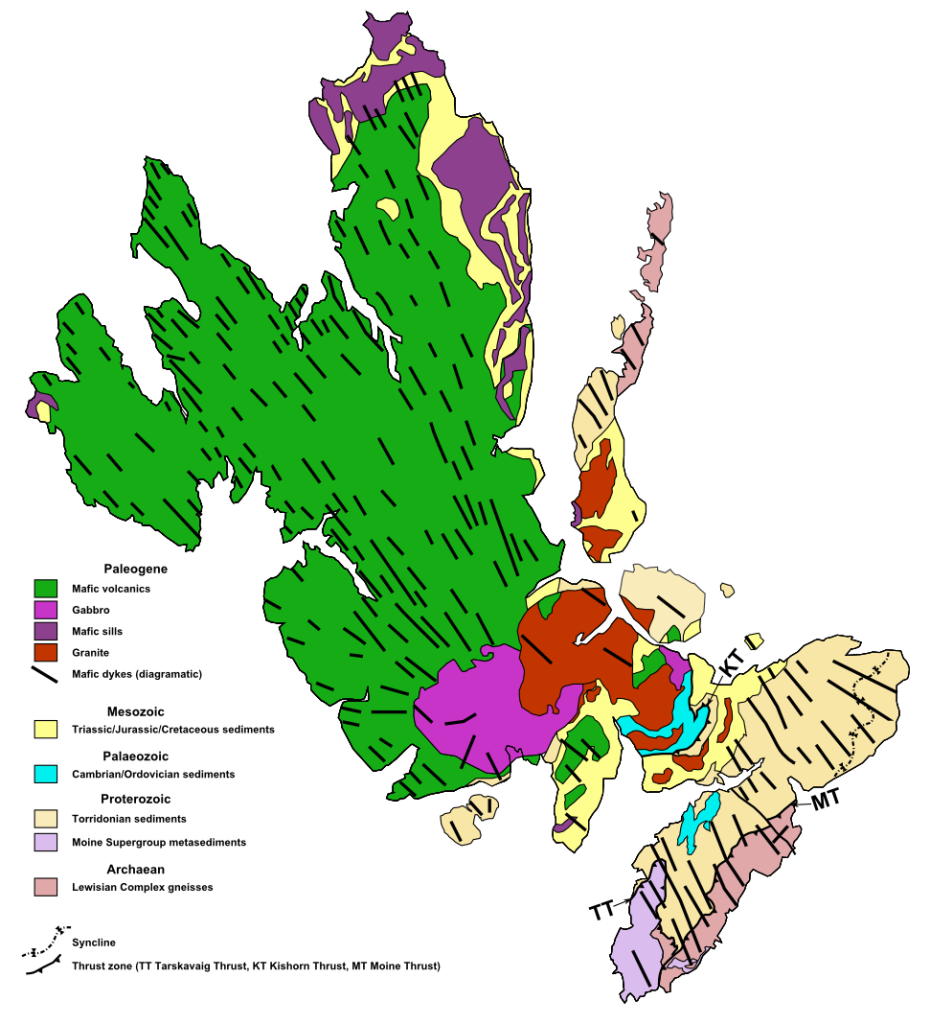 The browny-red centre is granite, in other words a circular “blob” of magma that has come up into a hole. The black lines are all dykes which (allowing for some movement of the crust) tend to come out radially from the central granite plug. And whilst less convincing, to the SE of the granite plug, we can see concentric rings of features.
The browny-red centre is granite, in other words a circular “blob” of magma that has come up into a hole. The black lines are all dykes which (allowing for some movement of the crust) tend to come out radially from the central granite plug. And whilst less convincing, to the SE of the granite plug, we can see concentric rings of features.Now take a look at some others dyke swarms:
And whilst rarer, there are also instances of the concentric dykes and similar features such as this one at Ardnamurchan in the western highlands of Scotland.
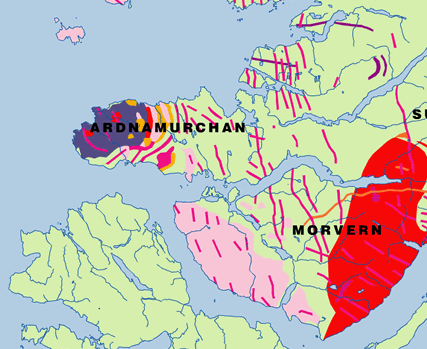
There is a striking similarity of features between the bullet holes in Dr Cristy’s building’s and the granite plugs, radial dykes and rarer concentric dykes in the earth’s crust.
But geologists either have not considered meteorites, or if they have, they have dismissed them. The current ideas for the cause of these “Dyke Swarms” (why does it sound like a feminist conference?) all involve volcanoes or igneous processes:
This study proposes three models to explain the mechanism of the three major types of mafic dyke swarms. Parallel dyke swarms form in response to a regional stress field, e.g. the mafic dyke swarms in the North China Craton, whereas small radiating dyke swarm forms due to stress constructions around a plutonic or volcanic edifice, such as the dyke swarm at Spanish Peak, USA. The third type of radiating dyke swarm is giant fan-shaped dyke swarm such as the Mackenzie dyke swarm. Fractures that formed prior to magmatism may play a vital role in dictating the dyke swarm geometry. In most of the cases, the pre-existing fractures are induced by tectonic stresses and not by magma injection though magma injection can increase the fracture size by propagation at the dyke tip. (Source)
However, unless you find the meteorite causing the “Gunshot hole”, it would not be easy to tell whether the volcanic eruption was the cause of the dykes (presumably through heat stress) or whether the volcanism occurred as the result of a meteorite puncture hole to the crust.
Rather like it’s impossible to say the holes in Dr Cristy’s building were definitely linked to earth day and global warming alarmists, so I’m not saying these holes have to be from meteorites hitting the earth, but neither can I see any way to dismiss this theory.
And finally – a video of an impact of a meteorite hitting a spherical hard surface. (Obviously with a lot more fizzing than we’d expect for a meteorite hitting the earth).


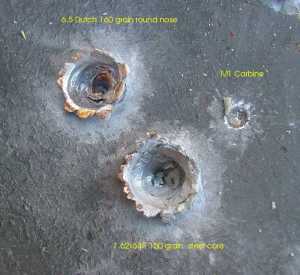
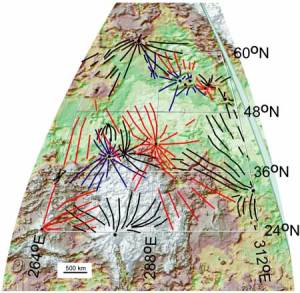
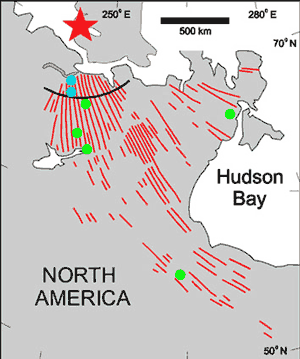

Quite visible. https://en.wikipedia.org/wiki/Siljan_(lake)
Yes, there’s a few – but not nearly enough compared to the moon!
As I heard it, the moon isn’t so pock marked because of steady bombardment but that both the Earth and the Moon were heavily impacted during one particular period. Long enough ago for the signs on Earth to be erased or covered. As you point out there are craters but not enough, but the Earth has many ways of losing those craters and only very modern equipment is finding signs of them. For example it took a long time to find the KT boundary crater and they weren’t looking for it.
If you look at the moon it appears the whole surface has been cratered. Which means that if I pick any random location on earth, it also ought to have had a crater at one time.
But if the meteorites didn’t form craters, but instead (large ones) punctured the crust and went straight through, that could explain it.
The Late Heavy Bombardment (abbreviated LHB and also known as the lunar cataclysm) is an event thought to have occurred approximately 4.1 to 3.8 billion years (Ga) ago…
Long enough for our own to have vanished almost totally. Chicxulub was a mere 65 million years ago and that was pretty hard to find.
Let’s suppose that there was such an event – why did it stop? The only reason it could stop would be because the meteorites landed on a planet. As such, we are not talking about an “event” but instead an exponential decay. But we also know that meteorites still hit the earth and that a big one hit in “modern” times around 66myrs ago. So, we’re still on the decay part of that curve.
The alternative is to see this “event” as being a bit like the heat hidden in the ocean – it’s there to explain something that doesn’t work as geologists would like it rather than as an actual fact.
It didn’t entirely stop but a great amount of loose material was hoovered up, mostly by Jupiter and Saturn in the same process that formed the solar system.
The problem is that the “there’s no meteorite craters” or “bullet holes” is a very self-fulfilling prophecy, because if you say there are none, no one looks and anyone who does is thought an idiot – and will not get funded to actually determine whether they have found one.
We’re back at the “CO2 will cause catastrophic warming … because no one will be funded unless they believe it” … kind of scenario.
The irony, is that no one really knows unless and until there is a systematic search for them … so unless academia is prepared to conceive that they might exist … it can never prove they exist … and just as equally it can never prove they do not exist.
You’re assuming that nobody is looking and that’s not true as evidenced by the documentary the other night
http://www.channel4.com/programmes/walking-through-time/on-demand/64143-001
Most of the tools for looking for them a very new and impact crater data are bundled together with other studies. Rock surveys for mineral rearches and other geological surveys. The group that’s trying to prove that the Younger Dryas was caused by an impact. Discoveries of spherials, olivine and ejecta, etc. Some people are searching deserts and ice sheets for smaller objects, not least because they’re valuable.
All the evidence is pointing to the existence of craters but they’re not common or easy to spot.
If you read today, the Bishop is now working for the GWPF. But as far as I know the GWPF have never done anything at all in Scotland. That means that with Andrew gone, that seems to mean that either someone like me ends up doing far more (for free) or nothing gets done. I originally started thinking a few months of effort and politicians would understand the scam and I could move on. But it sucked me in and I kept going thinking “only a little bit more effort and it’ll fall apart”. It’s now a decade later and I’ve got to conclude that even with Trump in office there’s no end in sight and with Andrew gone if I don’t actively detach myself and move on I will end up being sucked in even more. I really need to move on.
Australia has 30 impact craters out of 176 recognised worldwide.
In Australia seven distinct craters, ranging in size from about 25m to around 1km in diameter, have been recognised. Five of these are associated with meteorites. In addition, there are another 30 very much larger but deeply eroded and enigmatic circular scars that present some evidence of an origin by impact. Among the largest are Woodleigh in Western Australia (60-70km across), Lake Acraman in South Australia (greater than 35km) and Tookoonooka in Queensland (50km in diameter).
While their sizes have yet to be determined precisely, these three structures are clearly very old, and in the case of Woodleigh and Tookoonooka they have become buried beneath a mantle of younger sediments, such that they are no longer visible at the surface.
Thirteen other structures have been recognised, either as surface features or by geophysics. For these, there is little or no evidence other than their distinct circular shape to suggest they were formed from an impact. These structures include two underwater craters, Mercury and Maningrida, which occur off the coast of northern Australia.
On land, 11 structures tentatively identified as possible impact sites include:
Lorne Basin (a doubtful structure in New South Wales)
Gnargoo, Herbert, Ilkura, Lennis, and Skirmish (all in Western Australia)
Mingobar (Queensland)
Barramundi, Calvert Hills, Renehan and Wessel (all in the Northern Territory).
At this stage the origin of these structures, both on land and in the sea, are considered speculative. In total, some 50 of them have been recognised in Australia, to highly varying degrees of certainty.
This is an edited extract from the book Australia’s Meteorite Craters by Alex Bevan and Ken McNamara, published by the Western Australian Museum.
Of course, even if a circular structure is in sedimentary rock and clearly the result of “modern” erosion, the original shape of the rock may have been formed by a meteorite crater and then infilled, and now modern erosion is merely uncovering an ancient crater.
But then if you add folding and fault boundary movement, then the original circular structure could now be oval or even one part moved horizontally with respect to the rest.
The age of the craters on the moon is from +2billion yeas to 52 ma.
From that you can start to invoke deformation as a result of tectonic activity (none on the moon) in some age related context. In the words of Ross Cayley, of VGS fame: “Subduction Zones Eat Information”.
Given the wide date range and the intense tectonic activity since preservation of craters on Earth would be slim at best. Sedimentary basin coverage would further eliminate more recent evidence.
The elimination of surface features that took place during the last two ice ages similarly removes evidence in high latitudes.
Your interpretation of the geophysical data while interesting looks a little thin to say the least.
I could just reverse the criticism and say of the current model: “Your interpretation of the geophysical data while interesting looks a little thin to say the least.”
The problem is that I cannot see any easy way to distinguish between a volcanic eruption and a “bullet-eruption”. That’s because the meteorite would go straight through the crust and would be lodged deep in the earth.
In essence there are three alternative explanations of the same feature:
1. “Pressure induced” (the traditional explanation)
2. Thermal stress induced (as I explained in a previous post, simply heating the ground creates massive pressure)
3. Meteorite “gun-shot”.
But of all these the least easy to understand is “pressure induced”. Because where does the pressure come from – except lighter rock. And if there is lighter rock, surely the first small crack and the pressure will be released as in a volcano. So, I cannot see any mechanism to create massive 10s of km long dykes.
If you think about it, there is no evidence of planetary inpacts at all. The closest we have come to witnessing a planetary impact is Schumaker Levy nine’s encounter with Saturn which can’t really be described as an impact. The evidence we find in situ, traces of iridium and such are assumed to be the results of an impact.
So we see craters on every planetary body (where we can actually see the surface) but we have no direct evidence of bolides.
There are no oval craters, even on small bodies which can often have craters that cover a significant proportion of their surface area, see Stickney crater on Phobos or…well, all of Hyperion really.
There are a lot of polygonal craters, Teyths, Dione, Mimus, even the Chicxulub crater looks like a hexagon.
Cheers